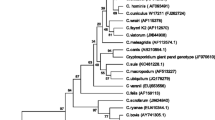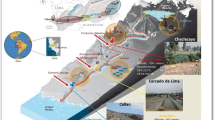Abstract
In the present study, fluorescent in situ hybridization (FISH) and monoclonal antibodies (MAbs) were evaluated for species-specific detection and viability determination of Giardia lamblia, Cryptosporidium parvum, and Cryptosporidium hominis in human fecal and water supply samples. A total of 50 fecal human samples positive for G. lamblia cysts, 38 positive for C. parvum, and 23 positive for C. hominis were studied. Also, 18 water supply samples positive for Giardia spp. and Cryptosporidium spp. by the United States Environmental Protection Agency (USEPA) Method 1623 were studied by FISH and fluorescein isothiocyanate (FITC)-conjugated MAbs. Eighteen percent of the fecal samples parasitologically positive for G. lamblia presented viable and nonviable cysts, and 5% of those positive for Cryptosporidium spp. presented viable and nonviable oocysts. Of the 18 water supply samples analyzed, 6 (33%) presented Giardia spp. viable and nonviable cysts and 2 (11%) presented viable and nonviable Cryptosporidium spp. oocysts. G. lamblia identification was confirmed by polymerase chain reaction (PCR) and sequencing of the β-giardin gene in the fecal and water samples found positive by FISH and FITC-conjugated MAbs. C. parvum and Cryptosporidium muris were identified, by PCR and sequencing of the small subunit of ribosomal RNA gene, in seven and one water samples, respectively. Our results confirm that this technique enables simultaneous visualization, species-specific identification, and viability determination of the organisms present in human fecal and water supply samples.



Similar content being viewed by others
References
Alves M, Matos O, Antunes F (2001) Multilocus PCR–RFLP analysis of Cryptosporidium isolates from HIV-infected patients from Portugal. Ann Trop Med Parasitol 95:627–632
Amann RI, Ludwig W, Schleifer KH (1995) Phylogenetic identification and in situ detection of individual microbial cells without cultivation. Microbiol Rev 59:143–169
Caccio SM, De Giacomo M, Pozio E (2002) Sequence analysis of the beta-giardin gene and development of a polymerase chain reaction-restriction fragment length polymorphism assay to genotype Giardia duodenalis cysts from human faecal samples. Int J Parasitol 32:1023–1030
Dorsch MR, Veal DA (2001) Oligonucleotide probes for specific detection of Giardia lamblia cysts by fluorescent in situ hybridization. J Appl Microbiol 90:836–842
Graczyk TK, Grimes BH, Knight R, Da Silva AJ, Pieniazek NJ, Veal DA (2003) Detection of Cryptosporidium parvum and Giardia lamblia carried by synanthropic flies by combined fluorescent in situ hybridization and a monoclonal antibody. Am J Trop Med Hyg 68:228–232
Jenkins M, Trout JM, Higgins J, Dorsch M, Veal D, Fayer R (2003) Comparison of tests for viable and infectious Cryptosporidium parvum oocysts. Parasitol Res 89:1–5
Mac Kenzie WR, Hoxie NJ, Proctor ME, Gradus MS, Blair KA, Peterson DE, Kazmierczak JJ, Addiss DG, Fox KR, Rose JB, Davis JP (1994) A massive outbreak in Milwaukee of Cryptosporidium infection transmitted through the public water supply. N Engl J Med 331:161–167
Matos O, Tomás A, Aguiar P, Casemore D, Antunes F (1998) Prevalence of cryptosporidiosis in AIDS patients with diarrhoea in Santa Maria Hospital, Lisbon. Folia Parasitol 45:62–65
Moter A, Gobel UB (2000) Fluorescence in situ hybridization (FISH) for direct visualization of microorganisms. J Microbiol Methods 41:85–112
Ono K, Tsuji H, Rai SK, Yamamoto A, Masuda K, Endo T, Hotta H, Kawamura T, Uga S (2001) Contamination of river water by Cryptosporidium parvum oocysts in western Japan. Appl Environ Microbiol 67:3832–3836
Slifko TR, Smith HV, Rose JB (2000) Emerging parasite zoonoses associated with water and food. Int J Parasitol 30:1379–1393
Smith JJ, Gunasekera TS, Barardi CR, Veal D, Vesey G (2004) Determination of Cryptosporidium parvum oocyst viability by fluorescence in situ hybridization using a ribosomal RNA-directed probe. J Appl Microbiol 96:409–417
Solo-Gabriele HM, Leroy Ager A Jr, Fitzgerald LJ, Dubon JM, Neumeister SM, Baum MK, Palmer CJ (1998) Occurrence of Cryptosporidium oocysts and Giardia cysts in water supplies of San Pedro Sula, Honduras. Rev Panam Salud Publica 4:398–400
Surl CG, Kim SM, Kim HC (2003) Viability of preserved Cryptosporidium baileyi oocysts. Korean J Parasitol 41:197–201
Tzipori S, Ward H (2002) Cryptosporidiosis: biology, pathogenesis and disease. Microbes Infect 4:1047–1058
United States Environmental Protection Agency (1998) Consumer confidence reports final rule. Fed Regist 63:160
Vesey G, Ashbolt N, Fricker EJ, Deere D, Williams KL, Veal DA, Dorsch M (1998) The use of a ribosomal RNA targeted oligonucleotide probe for fluorescent labelling of viable Cryptosporidium parvum oocysts. J Appl Microbiol 85:429–440
Acknowledgments
This work was supported by the Project POCTI/ESP/46369/2002 from Fundação para a Ciência e Tecnologia (FCT)/EU/FSE/FEDER and by a NATO Collaborative Linkage Grant, CLG 979765.
Author information
Authors and Affiliations
Corresponding author
Rights and permissions
About this article
Cite this article
Lemos, V., Graczyk, T.K., Alves, M. et al. Identification and determination of the viability of Giardia lamblia cysts and Cryptosporidium parvum and Cryptosporidium hominis oocysts in human fecal and water supply samples by fluorescent in situ hybridization (FISH) and monoclonal antibodies. Parasitol Res 98, 48–53 (2005). https://doi.org/10.1007/s00436-005-0018-6
Received:
Accepted:
Published:
Issue Date:
DOI: https://doi.org/10.1007/s00436-005-0018-6




